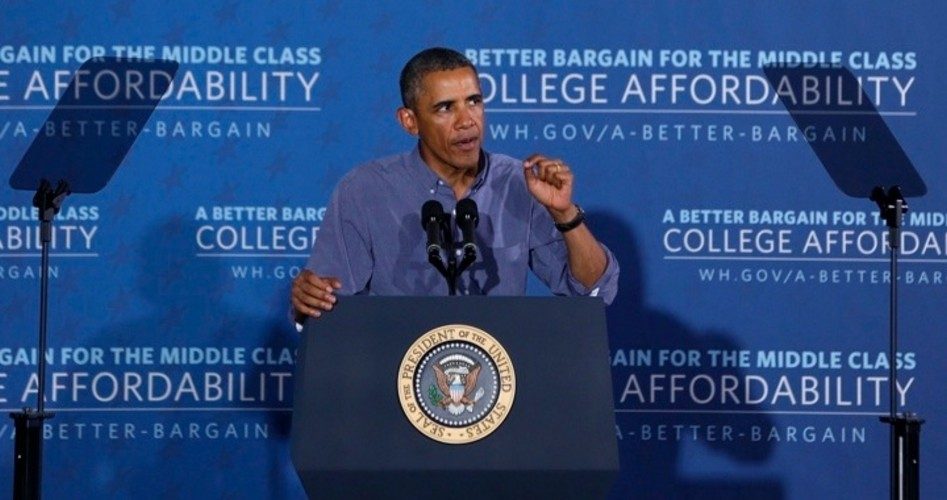
Despite overwhelming evidence that government meddling in higher education has led to soaring tuition costs and decreased quality at U.S. colleges and universities, Obama announced his latest scheme to use federal power in a supposed effort to make higher education more “affordable” while imposing new standards. Rather than following the advice of serious economists by letting the market reduce costs and improve quality, the president insisted this week that more government and more “reforms” were needed to achieve his goals.
Opponents of the agenda have already started lashing out, saying that the federal government has no constitutional authority to get involved in higher education to begin with. Critics of the plan also noted that, if enacted as described, it would see Washington, D.C., establishing federal “standards” for institutions of higher learning across America — a radical transformation that experts say will have far-ranging repercussions. As The New American has documented extensively, the federal takeover of K-12 education through national “Common Core” standards is well underway.
According to Obama, who unveiled the higher-education scheme this week during his two-day bus tour, the new plan to “reform” colleges and universities will involve a combination of taxpayer-funded carrots, sticks, and “shaming.” Demanding action from Congress, Obama called for the creation of, among other new programs, a federal “rating system” that would “rate” schools based on how well they comply with federal mandates and decrees on everything from costs to “quality.”
Eventually, under the proposal, taxpayer-funded student-aid would be linked to the controversial rating scheme, forcing colleges and universities to fall in line if they hope to keep receiving tax money unconstitutionally doled out by federal authorities. “It is time to stop subsidizing schools that are not producing good results,” Obama told students at the University of Buffalo, with “good results” presumably to be defined by federal bureaucrats. “We need to rate colleges on best value so students and taxpayers get a bigger bang for their buck.”
Skeptics, however, are already sounding the alarm. “The proposal would be a huge change in higher education, with the federal government asserting itself as the definer of institutional goals and policy, and doing it through need-based financial aid,” National Association of System Heads Executive Director Jane Wellman was quoted as saying in the New York Times. “The federal government has never been in higher education policy before — it has just administered financial aid — and I’m not sure you can just take that role and stretch it like a rubber band. It seems like a very clumsy way to try to reshape the roles of the federal government, the states, and the institutions’ boards.”
Republican lawmakers, meanwhile, are up in arms, blasting the plan as yet another federal overreach that could have devastating consequences. “The U.S. did not create the best higher education system in the world by using standards set by Washington bureaucrats,” declared Sen. Marco Rubio (R-Fla.) in a widely quoted statement about the plan, adding that he is “strongly opposed” to federal standards on higher-education institutions. “There are many things we can do to make higher education more affordable and available that do not involve massive increases in the federal government’s role in our nation’s higher education system…. This is a slippery slope, and one that ends with the private sector inevitably giving up more of its freedom to innovate and take risks.”
Incredibly, the president publicly claimed he could create his new “ratings” system using “executive actions,” promising to unveil it by 2015. By 2018, he claimed, federal funding would be tied to obedience to federal decrees. While apparently conceding that Congress would have to be cajoled into tying student aid to the new rating regime, Obama expressed confidence that his scheme would become a reality. “Colleges that keep their tuition down and are providing high-quality education are the ones that are going to see their taxpayer money going up,” he predicted, despite the fact that leading Republican lawmakers, who control the House of Representatives and may even take the Senate, have already slammed the idea.
Acknowledging that exploding costs — tuition has reportedly increased by some 250 percent over the last 30 years — are at least partly driven by the $150 billion in federal aid to students every year, Obama’s rhetoric largely focused on bringing down costs. “Higher education should not be a luxury. It is an economic imperative that every family in America should be able to afford,” he told students, seemingly oblivious to how the economy operates. “Colleges are not going to just be able to keep on increasing tuition year after year and passing it on to students…. We can’t price the middle class and everybody working to get into the middle class out of college.”
In an e-mail touting other recent education “reforms” to supporters through his political machine “Organizing for Action,” Obama said he was seeking “real reforms to fundamentally rethink how we pay for college in this country” — “it’s not enough just to tinker around the edges.” He urged OFA members, who could not muster a single supporter for a “climate change” rally this month, to lobby Congress about his latest plot. Even without lawmakers, however, Obama pledged that “my administration will continue to do what we can to make sure quality, affordable higher education is in reach for millions more young Americans.”
Education Secretary Arne Duncan, meanwhile, who has led the administration’s efforts to seize control over the K-12 educational system, echoed Obama’s claims, suggesting taxpayer funds should be doled out based on obedience to federal decrees. “We want to see good actors be rewarded. We want to see them get more resources,” he told reporters. “And when we’re not seeing that kind of commitment, we want to challenge that status quo.”
Unsurprisingly, Democrats in Congress promptly lined up to applaud the president’s latest proposal. House Committee on Education and the Workforce Chairman Rep. John Kline (R-Minn.), however, released a statement expressing serious doubts about the scheme. “I remain concerned that imposing an arbitrary college ranking system could curtail the very innovation we hope to encourage — and even lead to federal price controls,” he explained. “As always, the devil is in the details.”
Of course, the president’s broad agenda to, as he put it, “fundamentally transform” America, has a heavy emphasis on education — after all, if the youth represents the future, then ensuring control over education is crucial. In addition to bribing and bludgeoning state governments into adopting deeply controversial K-12 national standards, Obama has devoted a great deal of attention to higher education. The most recent initiative, signed into law last week, dealt with keeping student-loan interest rates far below market rates. Before that, under Obama’s leadership, the federal government began publishing “scorecards” for colleges, established a “college tax credit,” doubled funding for Pell grants, and more.
According to experts and economists, however, increasing the amount of taxpayer funding for higher education will inevitably lead to higher costs — just as it has in healthcare, K-12 education, and every other field where government has become involved. Virtually every economist understands that stepping up low-interest loans to students while reducing the amount they have to repay leads institutions of higher learning to raise tuitions. In addition to soaring costs, taxpayers are also being squeezed even harder to pay for it all. The alleged benefits, meanwhile, are dubious at best, and non-existent at worst.
The situation is similar abroad, too. “In contrast to the conventional wisdom, there is no compelling evidence to suggest that public subsidies to higher education have any economic benefit,” noted a report by researcher James Stanfield with the E.G. West Centre at Newcastle University. “Moreover, once its hidden costs and unintended consequences are taken into account, government intervention in higher education is doing far more harm than good, and is holding back the development of one of the UK’s most important service sectors.”
Beyond the pragmatic problems, the federal government has no constitutional authority to meddle in education — period. That includes subsidies, regulations, standards, student aid, and even the entire U.S. Department of Education, which conservatives have long sought to abolish. However, like with the countless other unconstitutional usurpations of power under Obama and previous administrations, analysts say the only way to stop it is for citizens to get involved.
Alex Newman is a correspondent for The New American, covering economics, politics, and more. He can be reached at [email protected].
Photo of President Obama: AP Images
Related articles:
Common Core: A Scheme to Rewrite Education
Orwellian Nightmare: Data-mining Your Kids
Higher Education: Brainwashing 101
Obama’s Solution to High College Costs: Fight Subsidies With Subsidies
Obama-linked Think Tank Wants Universal Preschool, More Child-care Subsidies



